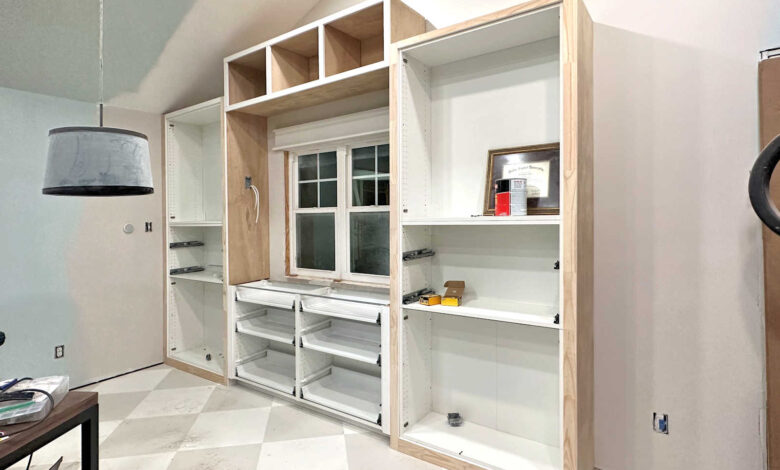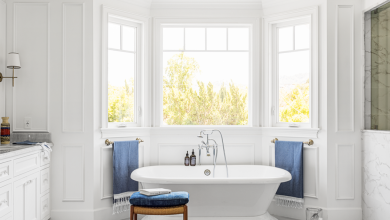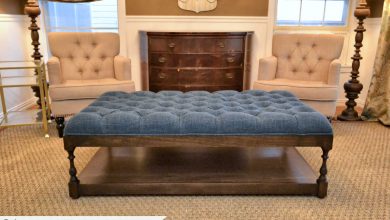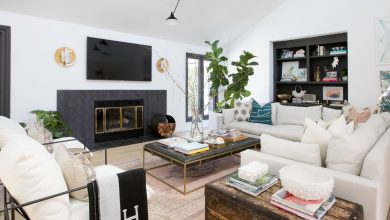Studio Office Cabinet Progress – Trimming Out The Cabinets

[ad_1]
I had a very productive day yesterday! I got all of the basic trim attached to the cabinets in the office area of the studio. I ran out of the time, so I didn’t get to attach the decorative trim, but the basic trim has gone a long way towards making this unit look finished and cohesive.
In my last post on this project, I had built the cubby bridge between the cabinets. At that point it looked like this…

If you missed the post where I showed how I built the cubby bridge by myself, you can see it here.
So with all of the basic trim attached, this is what the whole cabinet unit looked like at the end of the day last night…


I know it’s kind of difficult to make sense of it without the doors and drawer fronts, but I didn’t want to attach all of those for a picture and then have to remove them again. The more I handle them, the more of a chance I’m taking at scratching or damaging them, so we’ll all have to wait until next week to see the whole thing put together. So let me show you how I trimmed out this cabinet unit.
I started at the top and worked my way down. So starting with the cubby bridge, I cut and attached 1″ x 2″ pieces to the top and bottom. On both, I lined up the top edge of the 1″ x 2″ piece so that it was flush with the plywood on top and bottom of the bridge.


Next, I cut the vertical pieces and attached those. I attached all of this trim using 1.5-inch 16-gauge nails in my nail gun. I didn’t use any wood glue or construction adhesive. Just the nails.


Next, I worked on the cabinets on the left side of the unit. I had already attached 2″ x 2″ lumber to the sides of the unit, flush with the front edge of the IKEA cabinets, in previous steps. So in that same way, I needed to attach a 2″ x 2″ piece to the top so that I’d have something to nail the top trim to. I nailed from the inside of the cabinet, and into the 2″ x 2″ piece, making sure that the front edge of the 2″ x 2″ piece sat flush with the front side edges of the IKEA cabinet.


Then I began adding the trim, starting with the piece next to the wall. I measured the distance from the outside edge of the IKEA cabinet to the wall, and then used my table saw to rip a piece of 1″ x 4″ lumber to the correct width.


I also ran all of these trim pieces through my planer to plane them to 5/8-inch thickness since that’s the thickness of the IKEA Veddinge doors and drawer fronts. If I had used the 1-inch lumber (which is actually 3/4-inch thick) as-is, the trim would have stuck out 1/8-inch further than the doors and drawer fronts. I don’t really think that’s a big deal, and if I didn’t have a planer, I would have just used the 1-inch lumber as-is and treated the different thickness to an intentional design decision. 😀 But since I do have a planer, I decided to use it.
So with that piece ripped, planed, and cut to length, I nailed it to the 2″ x 2″ so that it completely covered that space between the cabinet and the wall.


Here’s another view. I’ll probably use some small trim (shoe molding, perhaps) to fill in that tiny gap that still remains between the trim piece and the wall. Or I may just end up caulking it. We’ll see.


Then I repeated that same process for the other side — rip, plane, cut, and nail into place.


When attaching face trim around IKEA cabinets, you have to be very sure that you don’t put the trim over the edge of the cabinet at all. The trim can come right up to that outside edge, but if you cover over any of that edge, it will prevent the doors and drawers from functioning properly.


Next, I did the exact same thing on the bottom of the cabinet. Quite honestly, I was making up the design as I went along. 😀 I had originally planned to build this cabinet area with decorative trim (like you would see on a bookcase) going all the way across the front of the whole cabinet unit along the floor. Then I thought I might want a toekick across the entire front of the whole unit. In the end, I decided to use both ideas and put decorative trim on the two outside tall cabinets, and a toe kick on the middle drawer section with the countertop.
In order to attach trim to the bottom, I first had to attach a 2″ x 2″ piece to the bottom of the cabinet. I forgot to take a picture of this step, but it’s the exact same thing I did on the top of the cabinet in the first step above. Just like on the other three sides of this tall cabinet, this 2″ x 2″ piece gave me something to nail this trim piece to.


And then finally, I attached the top trim piece.


Since I decided to do decorative trim on the outside cabinets, and a toekick on the middle section, I needed to add one more piece to this cabinet section before the basic trim was finished. I cut a piece of 1″ x 4″ wood to about six inches in length…


And I attached it right here, perpendicular to the front trim piece along the floor. I nailed it in place right through the front of the front trim piece and into the edge of this perpendicular piece. If you can’t envision the purpose for this piece, you’ll understand it in a little bit.


Since I had originally planned to do decorative trim (no toekick) across the front of the whole cabinet unit, I had installed these spacer pieces with the legs (which only served to assist me in holding that spacer in place easier while I screwed the spacer into place). But now that I wanted a toekick, I had to remove that little leg piece that was in the way.


I used my Dremel MultiMax oscillating saw to remove it quickly and easily, cutting that little leg flush with the bottom of the cabinet, and free up that space for a toekick.


And then I ripped, planed, and cut the trim piece to cover that spacer. Since this is the section with the toekick, I cut this trim piece the height of the cabinet, and did not have this piece go all the way to the floor.


With the basic trim installed on the left cabinet unit, I repeated that entire process on the right side.


The last thing to do was to install the toekick. Since I had attached the wood feet flush with the front of these cabinets, I had to move them back to make room for a toekick. You can see what I mean in the photo below. See how those wood block feet are right along the front edge of the cabinets?


I had attached them that way so that I could nail the decorative trim to those wood blocks. But now they were in the way of a toekick. So just like I had to do on the mural wall cabinets, I used my hammer and gave each block foot a good whack (they were only held on with hot glue, no screws or nails) to break them free and move them back. Here’s a close-up picture I took when I did this same process on the mural wall cabinets.


Once they were where I needed them to be for a toekick, I re-glued them into place (which was quite challenging in that tight area under the cabinet). Here’s another picture I took when I did this same process on the mural wall cabinets. You can see the feet moved back compared to the feet right along the front edge.


So once I had the feet on these cabinets moved back and re-glued into their new place, I cut and nailed the toekick to those wood blocks. And now you can see the purpose of those pieces I attached perpendicular to the front trim pieces on those side cabinet units.


Without those pieces, there would be a hole there. Once the toekick piece was nailed in place, I got my hot glue gun into that crack between the side perpendicular piece and the end of the toekick, squeezed some glue along the end of the toekick piece, and then used a tiny prybar to snug that perpendicular piece to the toekick until the glue dried. So now that perpendicular piece is securely in place along the front nailed edge and the back where it’s glued.


And with that, the basic trim was finished!


I was disappointed that I ran out of time to do the decorative trim, but I don’t like using my tools outside past 9:00pm. So I still need to add crown molding to the top of each section…


And then I will add decorative trim to the bottom of the side cabinet units.


I haven’t decided yet if I’ll add trim (shoe molding or quarter round) in this area where the plywood meets the wall. But if I do, that will have to wait until after I’ve built the countertop. Since I’ll be painting the wall the same color as the cabinets, I may just use caulk to fill in those tiny cracks rather than using trim.


So that’s the progress! It’s coming along, and I’m thrilled with how it’s turning out!


Addicted 2 Decorating is where I share my DIY and decorating journey as I remodel and decorate the 1948 fixer upper that my husband, Matt, and I bought in 2013. Matt has M.S. and is unable to do physical work, so I do the majority of the work on the house by myself. You can learn more about me here.
[ad_2]
Source link







